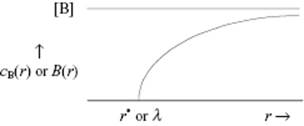Liquid-State Physical Chemistry: Fundamentals, Modeling, and Applications (2013)
14. Some Special Topics: Reactions in Solutions
14.4. Diffusion Control
The main task in this section is to estimate the rate constants for diffusion kD and k−D. While the reactants may be either neutral or ionic, we start with ionic reactions.
The flux jA – that is, the number of moles of ions crossing a unit area per unit time – of ions A with molarity cA across a surface normal to the mass velocity vA is given by
(14.32) ![]()
with the mobility uA and electric field E. The factor zA/|zA| is introduced to fix the sign of the charge zAe of the ion A, since a positive ion has a positive flux in the direction of E. For this expression it is assumed that the flux is parallel to the electric field. With an additional concentration gradient, also assumed to be parallel to the electric field, the total flux in the direction of decreasing concentration becomes
(14.33) ![]()
with DA the diffusion coefficient relative to the solvent. For the rate with which the reactant ions A and B approach each other we must replace DA by DA + DB.
Consider now the first step of the scheme in Eq. (14.25), where the labels A and B represent ions with charge zA and zB, respectively. We assume that a gradient in cB is present around each A ion, and vice versa. Using the Nernst–Einstein relation (Eq. 12.67)
(14.34) ![]()
and the relation between electric field Ez = −∂ϕ/∂z, with ϕ the electric potential, and potential energy Φ(r)
(14.35) ![]()
we obtain for the flux of B ions across a sphere of radius r around each ion A
(14.36) ![]()
where the overall negative sign disappears because the flux is now taken in the direction of increasing concentration. To illustrate the following argument more clearly, we ignore the dΦB(r)/dr contribution for the moment and add it again later.
The flow is JB = 4πr2jB, and we obtain for the molarity cB(r)
(14.37) ![]()
The flow JB can be taken outside the integral because under steady-state conditions the value of the flow is independent of the radius of the sphere. Because cB(∞) represents the bulk molarity [B], the total result is
(14.38) ![]()
We now assume that, if ion A approaches ion B within a critical radius r*, a reaction occurs and cB(r) = 0 for r < r* (Figure 14.3). This implies that the concentration gradient does not extend to r = 0 since all ions are lost reaching r*. The flow thus becomes
(14.39) ![]()
so that the rate of reaction reads
(14.40) ![]()
Figure 14.3 The behavior of cB(r) and B(r) as a function of r.

The rate constant kD is thus proportional to the diffusion constants, as expected, and a critical length r*.
Let us now introduce the dΦB(r)/dr contribution again. To solve the complete Eq. (14.36) we use a somewhat unexpected “Ansatz,” and note that if we differentiate the function
(14.41) ![]()
we obtain
(14.42) ![]()
From Eq. (14.36) we thus have
(14.43) ![]()
The integration corresponding to Eq. (14.37) becomes
(14.44) ![]()
where B(∞) is simply cB(∞) = [B] and λ has the dimensions of length. Making the same assumption of a critical radius r* where cB(r) = 0 and hence B(r) = 0, the total result is
(14.45) ![]()
(14.46) ![]()
Finally, we must link λ with r*, and this is done by assuming that the potential energy between two ions is given by
(14.47) ![]()
where the subscripts are omitted since the expression is symmetric in A and B. As usual, ε0 and εr are the permittivity of vacuum and the relative permittivity, respectively. Substituting in Eq. (14.43) for λ and integrating results in
(14.48) ![]()
which, as it should, results in λ = r* for Φ(r) = 0 for r > r*. The behavior of the concentration profile cB(r) and function B(r) as a function of r is sketched in Figure 14.3.
For the dimension of kD we have to consider the dimension of D which is m2 s−1; hence, kD will have dimension m3 s−1. Conversion to molar quantities is achieved by multiplying with Avogadro's number NA.
The rate constant for the reverse diffusion k−D in the scheme of Eq. (14.25) is the reciprocal of the time in which A and B remain nearest neighbors. If specific interactions are absent, this quantity can be estimated from random walk diffusion d = (6Dt)1/2, where d is the diffusion distance in time t. Hence, in this case k−D is given by
(14.49) ![]()
Clearly, the controlling parameters for the controlled reactions are the charges zA and zB, the permittivity εr, and the diffusion coefficients DA and DB. Moreover, we need an estimate for r*, which is essentially an empirical parameter. We discuss the agreement with experiment after we have dealt with reaction control.